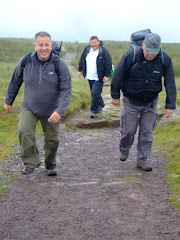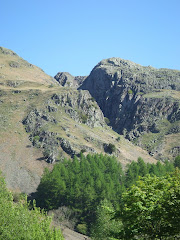Regarded my many highly respected gastro's as the 'Glastonbury of food festivals' the highlight of this year's visit for Wandering were the Churros dipped in chocolate sauce by Churros con Chocolate.
Christmas Food Festival takes place on Sunday 9th December.
Festival website
Sunday, September 16, 2012
Friday, September 14, 2012
Stage 6 - Tour of Britain 2012


It was always the intention of Wandering to be a spectator on this stage of the Tour of Britain but Lord Twynyrodyn expressed a curious interest when it was mentioned in a conversation between them, so it was two Strollers that made the short journey to the Storey Arms at mid-morning.

The start of this stage was from the National Trust's Powis Castle completing a loop of Welshpool before a fast descent of the Honddu valley. Soon after leaving Brecon the A470 gradually begins the climb in the shadow of Pen-Y-Fan, as the steepness of the gradient increases after Libanus, which starts the seven-kilometre SKODA King of the Mountains climb up to Storey Arms.
There were big crowds lining the route north of Storey Arms as we took our vantage point. Because of significant head-winds the peloton was behind schedule as they thundered past heading towards the open moorland that eventually descends to Penderyn and Hirwaun.

A brief climb to Ystrad Mynach through Nelson and Parc Penalta, towards Llanbradach to the edge of Caerphilly. The route passed Caerphilly Castle taking the one-way system the wrong way in order to maximise the approach to the climb, which proved to be one of the iconic moments of this years Tour of Britain.
The stage was eventually won by Leopold Koenig, of the Team NetApp with Jonathan Tiernan-Locke, of Endura Racing taking second place on the stage and overall GC winner.
Brief video footage taken by Wandering as the peloton passed our vantage point on the climb to the Storey Arms!!
Wednesday, September 12, 2012
Mercy
A thought provoking video from the Dave Matthews Band.
"Mercy" embraces the song's themes of unity and harmony in a new collaborative video, made with the help of a few thousand fans. According to the band, 14,334 people provided original photos and videos for the inspirational clip.
Matthews recently told 'Billboard' that he hopes this release "inspires [people] to find the things that they love, inspires them to feel good, to feel love, or ambition, or feel powerful. Whatever they need."
"Mercy" is realesed from the Dave Matthews Band's latest album, Away From the World.
"Mercy" embraces the song's themes of unity and harmony in a new collaborative video, made with the help of a few thousand fans. According to the band, 14,334 people provided original photos and videos for the inspirational clip.
Matthews recently told 'Billboard' that he hopes this release "inspires [people] to find the things that they love, inspires them to feel good, to feel love, or ambition, or feel powerful. Whatever they need."
"Mercy" is realesed from the Dave Matthews Band's latest album, Away From the World.
Thursday, September 6, 2012
Garth Mountain

This was a walk that was partially abandoned earlier this year in low cloud, so with the recent spell of good weather a 'second attempt' was made to reach the summit trig point.
Another reason for completing the walk was football related. During 2010/11, the Martyrs spent a season in exile away from our spiritual home of Penydarren Park, during the games in the Western league I often used to gaze up at Garth Mountain and wonder what the Rhiw Dda'r ground looked like from the bluff, 1,000 feet above the extremely busy A470.

Well I was about to find out.
The early stage of the walk was exactly the same as the original, starting from the Lewis Arms car park. However, on this occasion I climbed the steep path that eventually led to the bluff, that is so prominently visible from the A470 as you approach the outskirts of Cardiff.

And there it was the ground were the Martyrs spent a year in exile climbing their way back through the non-league pyramid.

The all-round views are really spectacular. With Cardiff Bay to the South and Castell Coch just a few miles away, to Llantrisant in the west and Caerphilly Mountain in the north-east. After gazing at the two main communities situated directly beneath the mountain - Taff's Well and Gwaelodygarth, it was onwards to the trig point.

The circular route was completed when you leave the mountain to return through Pentyrch and back to the Lewis Arms.

The movie staring Hugh Grant, 'the Englishman Who Went Up a Hill But Came Down a Mountain', is based on a story about the village of Taff's Well and the neighbouring Garth Hill.
Set in 1917 (with World War I as a backdrop), the film is based on two English cartographers. They arrive to measure the local "mountain" – only to cause outrage when they conclude that it is only a hill because it is slightly short of the required 1000 feet in height. The villagers, aided and abetted by the wily Morgan the Goat and the Reverend Mr Jones (who after initially opposing the scheme, grasps its symbolism in restoring the community's war-damaged self-esteem), conspire to delay the cartographers' departure while they build an earth cairn on top of the hill to make it high enough to be considered a mountain.
Saturday, August 4, 2012
St. Davids

After a welcome overnight rest in the Golden Lion, Newport, a non-walking day consisted of a visit to St Davids Cathedral. The walking clothes were still drying out after yesterday's drenching!
Set a few miles inland from a spectacular Pembrokeshire peninsula jutting out into the Atlantic, upon the site of an earlier sixth-century monastery built by St David, the Patron Saint of Wales, St Davids Cathedral has been a site of pilgrimage and worship for more than 800 years.

The monastic community was originally founded by Saint David, Abbot of Menevia, who died in 589. Between 645 and 1097, the community was attacked many times by raiders, including the Vikings, however, it was of such note as both a religious and intellectual centre that King Alfred summoned help from the monastic community at St. David's in rebuilding the intellectual life of the Kingdom of Wessex.
In 1081, William the Conqueror visited St. David's to pray, and thus recognised it as a holy and respected place.

Work on the present cathedral began sometime between 1180 and 1182 and is the culmination of centuries of rebuilding and expansion. Constructed in the Transitional Norman style using fine-grained, purple Cambrian sandstone, it has survived both the collapse of its tower and an earthquake in the 13th century, although today the floor slopes noticeably, the arcades veer from the vertical, and the east and west ends of the building differ in height by about four metres!

The restored Shrine of St David was unveiled and re-dedicated by The Right Reverend Wyn Evans, Bishop of St Davids, at a Choral Eucharist on St David's Day 2012. Sarah Crisp painted and gilded the five icons which have been installed to sit within the exisiting niches of the restored shrine. The icons, made in egg tempera on gesso, depict St David and other saints associated with the cathedral and the local area. The three icons at the front of shrine depict from left to right: St Patrick, St David and St Andrew. The icons are painted on lime wood panels and combine the styles of classic Byzantine with early Italian works. Traditional paint and techniques were used throughout.
The Cathedral has also been used as a location for a BBC production called "The Hollow Crown" as part of the castle of Richard II.
The title of "city" was re-instated to St. David's, and formally conferred by Her Majesty Queen Elizabeth II on 1 June 1995.

The weather had been glorious all day in St. Davids and reluctantly it was decided to return to Newport Sands where ice-creams were consumed before it started to rain!!
Friday, August 3, 2012
Poppit Sands to Newport


Boarding the Poppit Rocket outside the Castle Hotel in Newport at 10:30am the weather was blustery but sunny. The journey to the start of the walk took over half an hour along the narrow Pembrokeshire country lanes via Moylegrove.
After departing the 'Rocket' in the large car park at Poppit Sands on the mouth of the River Teifi, the costal path starts to climb almost immediately following a minor road past the Youth Hostel to Allt-Y-Goed Farm, where it becomes a footpath.

This takes you to Cemaes Head which is now a nature reserve owned by the Wildlife Trust, where guillemots, cormorants, fulmars and razorbills nest in the cliffs in Spring and early Summer, but not today!

The geology of this section of the coastline is spectacular. The cliffs at Pwll Granant in places are 600 feet high and consist of layers of sandstone and mudstone.
Arriving at Ceibwr Bay after a few hours walk the weather had remained kind. The steep valley down which the Nant Ceibwr flows was deepened by glacial meltwater in the Ice Age. Lunch was taken overlooking a group of school children coasteering along the rocky outcrops in the bay below.


Less than a mile further along the coastal path is the Witches Cauldron (Pwll-Y-Wrach) which is a natrually formed blow-hole caused by the collapse of a cave roof.

Soon after this point the weather deteriorated and it started to rain and the conditions were made difficult by the prevailing head-wind. This particular section of the coastal path is remote and extremely challenging, rising and falling quite dramatically in places. After the downhill trundle you know that a trudge upwards is always inevitable!

Before turning the headland a shoal of porpoises were clearly visible in the sea below.

After five hours the welcome sight of Newport Sands and the Nevern Estuary finally came into view, although there was still a few miles to walk to reach the Golf Club.
Over half of the 15 mile walk had been completed in driving rain and strong head-winds!
Photographs taken on this walk can be viewed here. Select 'slide-show' for automated viewing.
Wednesday, August 1, 2012
Wiggins wins Olympic Time Trial

Bradley Wiggins wrote his name into Olympic and cycling history at Hampton Court with a superb gold medal in the men's time trial. He was now won more Olympic medals than any other Briton: seven in total, including four gold. Team Sky rider Chris Froome won a bronze medal.
Wiggins, who also won the Tour de France less than two weeks ago, destroyed the field with a sensational ride to cover the 44km course in 50min 39.54 seconds, an impressive 42 seconds ahead of the the world time trial champion Tony Martin from Germany, who took the silver medal in 51:21.54.
There was further joy for Great Britain when Froome, who was the main support rider to Wiggins in the Tour de France, fought his way round the course to take the bronze medal, at an average speed of just over 30mph to finish in 51:47.87.
Wiggins's also equalled the achievement of his boyhood hero Miguel Indurain in winning the Tour de France and the Olympic time trial.
He produced a beautifully balanced effort over a course which was packed all the way by supporters waving union flags, a once in a lifetime experience for a British rider. Police estimate that there were in excess of 300,000 lining the roads.
"I cannot put it into words, I wouldn't do it justice," Wiggns said. "It’s really incredible to win an Olympic Gold in your home city. When you win in the velodrome there are three or four thousand people cheering. Here, around the streets of London, the noise is just amazing. I don't think anything will top that. It's just been phenomenal."
Subscribe to:
Posts (Atom)





































